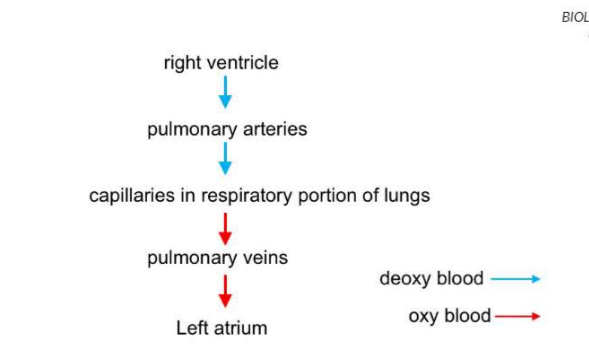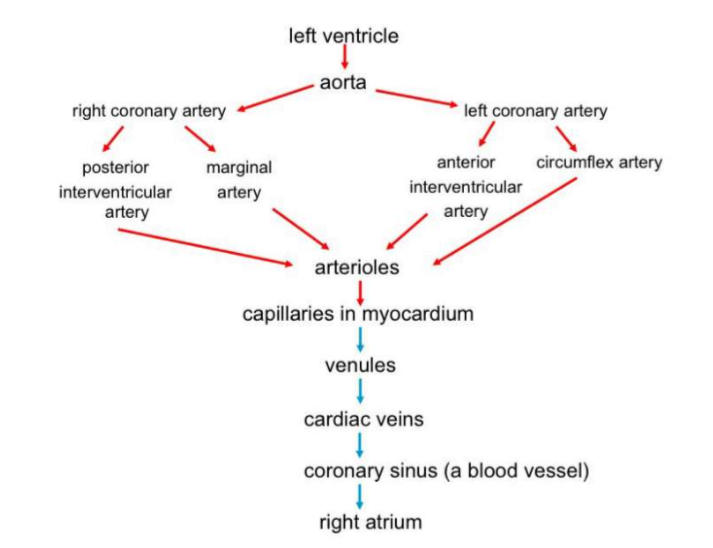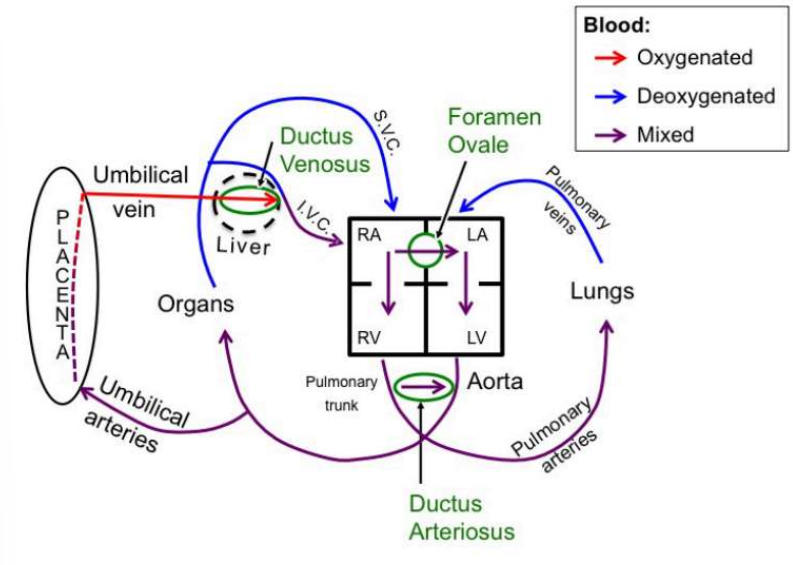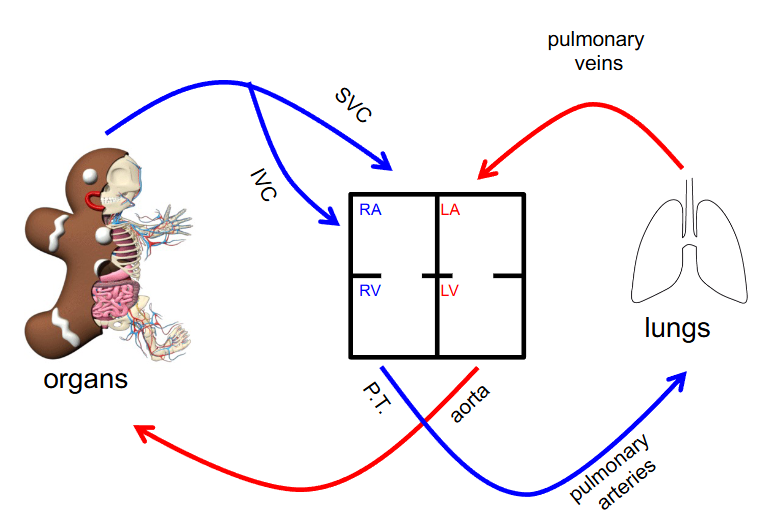Unit 12 - cardiovascular unit pt 2
covers circulatory routes, fetal circulation, blood, hemopoiesis/hematopoiesis and related medical conditions
-
What does closed, double circulation entail?
closed = blood confined to heard and blood vessels
double = 2 routes (pulmonary and systemic)
-
What are the 3 circulations in adult circulation?
pulmonary circulation, systemic circulation, and coronary circulation
-
What is pulmonary circulation for? what does it do?
- its for oxygenated of the blood
- carries blood from right ventricle to lungs (deoxygenated blood via pulmonary arteries)
- picks up oxygen in lungs via capillaries
- carries blood from lungs to left atria (oxygenated blood via pulmonary veins)
-
What is the route of pulmonary circulation?

-
What does systemic circulation do?
- for delivery of oxygenated blood to all other tissues
- carries (oxygenated) blood from left ventricle to organs via aorta
- organs take oxygen from blood via capillaries
- carries deoxygenated blood from organs to right atrium via superior and inferior vena cava
- many subdivisions of routes to individual organs/organ systems
-
What is coronary circulation?
- the system of vessels around the heart
-
What is the path of coronary circulation?

-
What is general over view of fetal circulation?
- fetus get oxygen and nutrients, and expels wastes to mothers blood
- exchange site in the placenta
-
What are the differences between fetal and adult circulation?
- umbilical vein (towards fetal heart) carries oxygenated blood from placenta to vena cava
- lungs and liver are late to develop and their functions are handled by maternal organs
umbilical arteries (away from fetal heart( returns mixed blood to placenta
-
How do fetus rely on maternal organs in circulation?
- 3 shunts allow most blood to bypass these organs (minimal blood flow to these organs for growth)
- following birth all shunts normally become closed
-
What are the 3 fetal shunts?
- ductus venosus (connects umbilical vein to inferior vena cava, permits most oxy blood to bypass liver capillaries)
- foramen ovale (hole in interatrial septum, allows blood to move from right to left atrium bypassing fetal lungs)
- ductus arteriosus (connects pulmonary trunk and aorta, bypassing fetal lung)
-
What is the path of fetal circulation?

-
What are the characteristics of blood?
- higher viscosity than H20
- pH 7.35 - 7.45
- 4 - 6L in an adult
-
What is blood composed of?
- plasma (matrix) makes up 55-60% of volume (fluid portion with solutes)
- formed elements make up 40-45% of volume (cellular portion)
-
What are the composition details of plasma?
- composed of H20 (90%), proteins (8%), and other solutes (2%)
-
What are the proteins in plasma?
- albumins (most plentiful plasma protein, carries substances (hormones, enzymes, etc) through body, helps tissue water balance)
- fibrinogen (clot formation)
- globulin (antibodies, detect and bind foreign invaders)
- protein based hormones and enzymes
-
What other solutes than proteins are in plasma?
nutrients, vitamins, wastes, electrolytes, blood gases (oxygen and carbon dioxide)
-
What are the formed elements in blood?
- red blood cells (erythrocytes, most abundant cell in body)
- White blood cells (leukocytes)
- platelets
-
What are platelets?
- fragments of cells called megakaryocytes
- involved in clotting
- life span ~10 days (if not used in clotting)
-
What are red blood cells?
- binds to and transports most of oxygen in blood
- anucleate when mature
- biconcave disk shape
- life span of ~ 120 days and old cells are destroyed in liver and spleen
-
What is hematocrit?
percent of blood volume made up by red blood cells (usually ~45%)
-
What do red blood cells contain?
- hemoglobin (iron-containing pigment protein)
- four globin chains (protein)
- four iron containing heme groups (gives blood red colour), 1 iron per heme and site of reversible oxygen binding
-
What are white blood cells (leukocytes)? What are theyre types?
- nucleated
- varying life span (days to years)
- defends against disease
- has two types: granulocytes (contain visible protein granules) and agranulocytes (lacks visible protein granules)
-
What do granulocytes include?
- neutrophils (~60%) kill bacteria, all phagocytic (engulf + digest invaders)
- eosinophils (~3%) attacks blood parasites
- basophils (~1%) release chemicals involved in inflammation and reduction of blood clotting during immune responses
-
What do agranulocytes include?
- lymphocytes (~35%) for immunity (two types)
- monocytes (~5%) enter tissues and enlarge to become macropages phagocytic
-
What are the two types of lymphocyte?
- T lymphocyte (activate immune response, kill tumour or virus infected/diseased cells directly
- B lymphocytes (become plasma cells that release antibodies to circulate in plasma)
-
What is hemopoiesis/hematopoiesis?
- formation of blood cells
- all blood cells arise indirectly from hemocytoblast cells (part of stem cells) in red bone marrow (located in adults in axial skeleton, pelvic & pectoral girdles, and proximal ends of humerus & femur)
-
What are related medical conditions to the cardiovascular system?
- atrial septal defect (hole in the interatrial septum)
- atherosclerosis (build up of fat deposits in the tunica intima that leads to narrowing or blocking of arteries)
-
What is the complete of the systemic and pulmonary circulatory systems?


